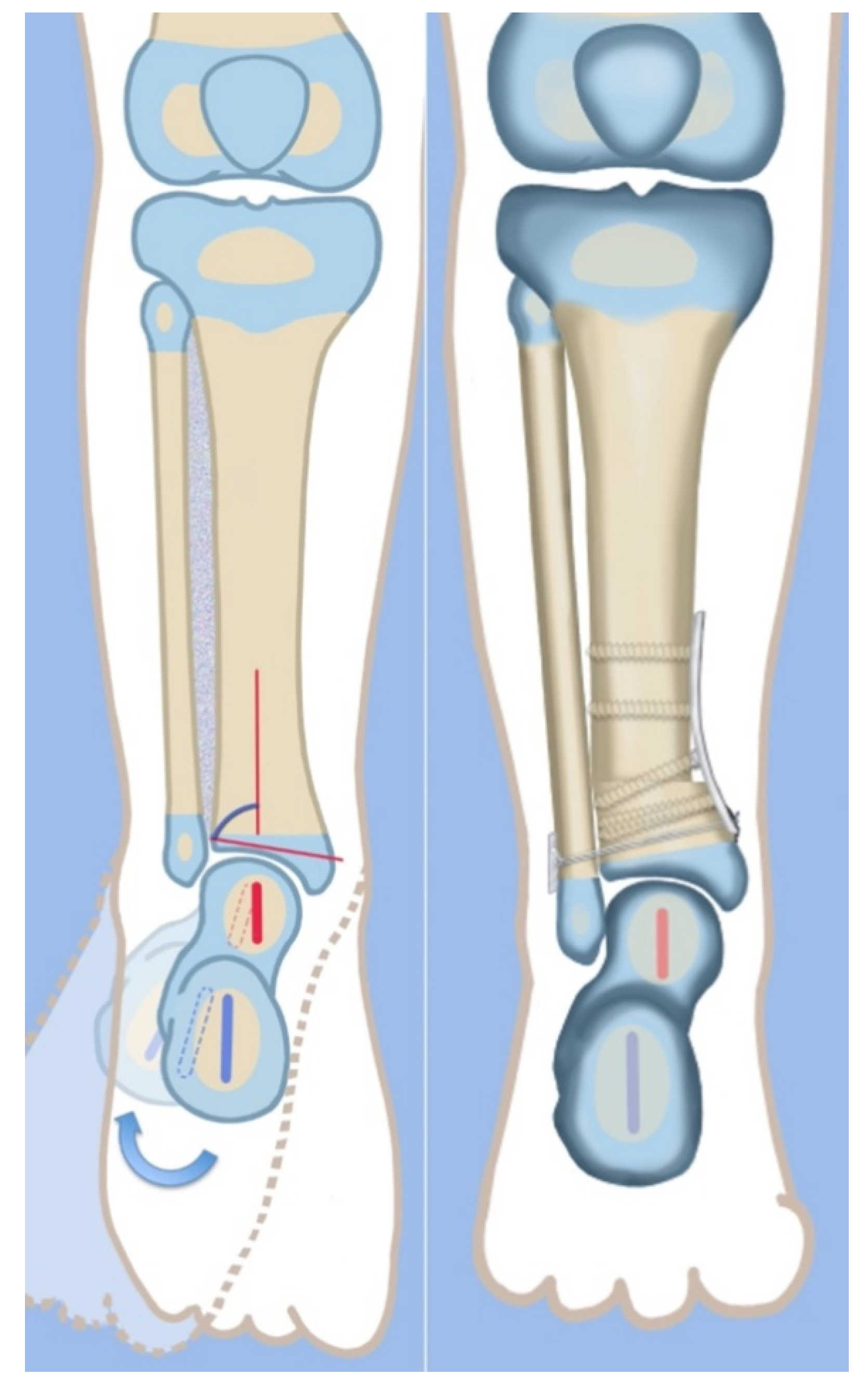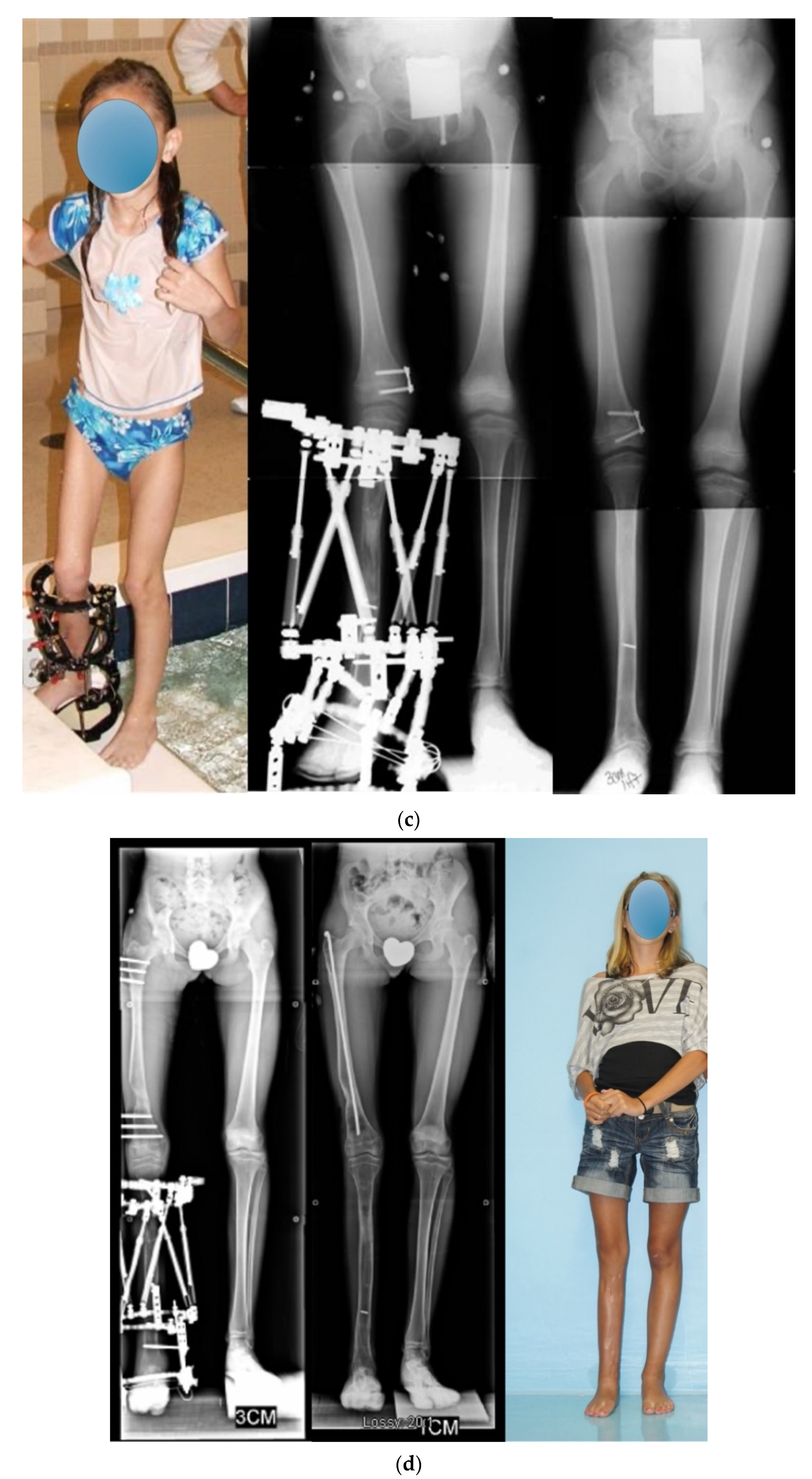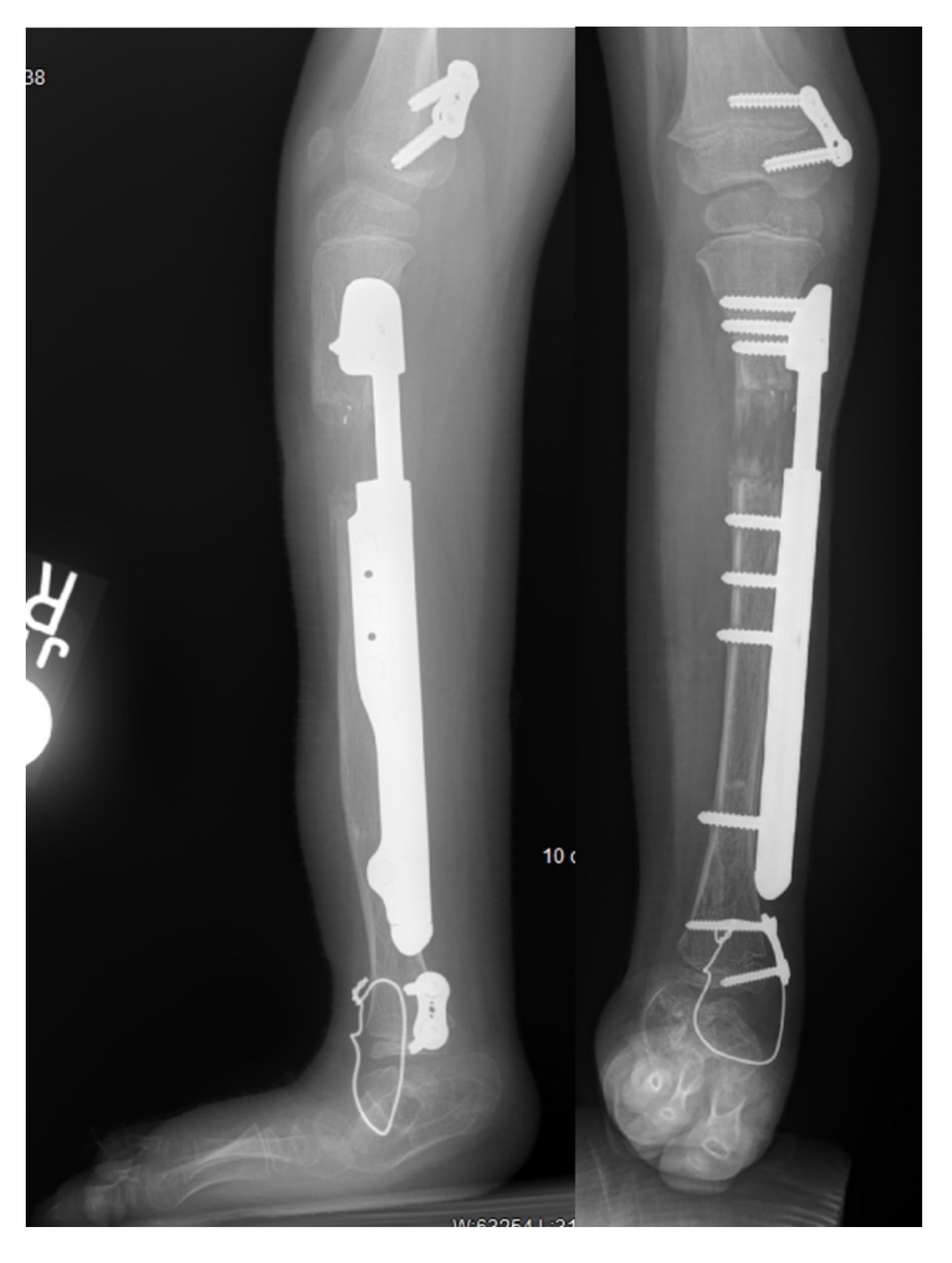Lengthening Reconstruction Surgery for Fibular Hemimelia: A Review
Abstract
:1. Introduction
2. Classification
3. Radiographic Examination
4. Magnetic Resonance Imaging and Computed Tomography
5. Foot and Ankle Reconstruction
6. Knee Valgus Deformities
7. Knee Ligaments
8. Toe/Metatarsal Surgery
9. Lengthening
10. Results
11. Conclusions
Author Contributions
Funding
Institutional Review Board Statement
Conflicts of Interest
References
- Rogala, E.J.; Wynne-Davies, R.; Littlejohn, A.; Gormley, J. Congenital limb anomalies: Frequency and aetiological factors. Data from the Edinburgh Register of the Newborn (1964–68). J. Med. Genet. 1970, 11, 221–233. [Google Scholar] [CrossRef] [Green Version]
- Boakes, J.L.; Stevens, P.M.; Moseley, R.F. Treatment of genu valgus deformity in congenital absence of the fibula. J. Pediatr. Orthop. 1991, 11, 721–724. [Google Scholar] [CrossRef]
- Froster, U.G.; Baird, P.A. Congenital defects of lower limbs and associated malformations: A population based study. Am. J. Med. Genet. 1993, 45, 60–64. [Google Scholar] [CrossRef]
- Manner, H.M.; Radler, C.; Ganger, R.; Grill, F. Knee deformity in congenital longitudinal deficiencies of the lower extremity. Clin. Orthop. Relat. Res. 2006, 448, 185–192. [Google Scholar] [CrossRef]
- Manner, H.M.; Radler, C.; Ganger, R.; Grill, F. Dysplasia of the cruciate ligaments: Radiographic assessment and classification. J. Bone Joint Surg. Am. 2006, 88, 130–137. [Google Scholar] [CrossRef]
- Paley, D.; Bhave, A.; Herzenberg, J.E.; Bowen, J.R. Multiplier method for predicting limb-length discrepancy. J. Bone Joint Surg. Am. 2000, 82, 1432–1446. [Google Scholar] [CrossRef] [Green Version]
- Shapiro, F. Developmental patterns in lower-extremity length discrepancies. J. Bone Joint Surg. Am. 1982, 64, 639–651. [Google Scholar] [CrossRef] [Green Version]
- Anderson, M.; Green, W.T.; Messner, M.B. Growth and predictions of growth in the lower extremities. J. Bone Joint Surg. Am. 1963, 45, 1–14. [Google Scholar] [CrossRef] [PubMed]
- Moseley, C.F. A straight-line graph for leg-length discrepancies. J. Bone Joint Surg. Am. 1977, 59, 174–179. [Google Scholar] [CrossRef] [PubMed]
- Amstutz, H.C. Natural history and treatment of congenital absence of the fibula. J. Bone Joint Surg. Am. 1972, 54, 1349. [Google Scholar]
- Coventry, M.B.; Johnson, E.W. Congenital absence of the fibula. J. Bone Joint Surg. Am. 1952, 34, 941–955. [Google Scholar] [CrossRef] [PubMed]
- Achterman, C.; Kalamchi, A. Congenital deficiency of the fibula. J. Bone Joint Surg. Br. 1979, 61, 133–157. [Google Scholar] [CrossRef] [PubMed]
- Dal Monte, A.; Donzelli, O. Tibial lengthening according to Ilizarov in congenital hypoplasia of the leg. J. Pediatr. Orthop. 1987, 7, 135–138. [Google Scholar] [CrossRef] [PubMed]
- Birch, J.G.; Lincoln, T.L.; Mack, P.W.; Birch, C.M. Congenital fibular deficiency: A review of thirty years’ experience at one institution and a proposed classification system based on clinical deformity. J. Bone Joint Surg. Am. 2011, 93, 1144–1151. [Google Scholar] [CrossRef]
- Stanitski, D.F.; Stanitski, C.L. Fibular hemimelia: A new classification system. J. Pediatr. Orthop. 2003, 23, 30–34. [Google Scholar] [CrossRef]
- Herzenberg, J.E.; Paley, D.; Gillespie, R. Limb deficiency. In Pediatric Orthopaedic Secrets, 2nd ed.; Staheli, L.T., Ed.; Hanley and Belfus: Philadelphia, PA, USA, 2003; pp. 406–416. [Google Scholar]
- Herzenberg, J.E.; Shabtai, L.; Standard, S.C. Fibular hemimelia: Principles and techniques of management. In Pediatric Lower Limb Deformities, Principles and Techniques of Management, 1st ed.; Sabharwal, S., Ed.; Springer International Publishing: Cham, Switzerland, 2016; pp. 427–454. [Google Scholar]
- Paley, D. Surgical reconstruction for fibular hemimelia. J. Child. Orthop. 2016, 10, 557–583. [Google Scholar] [CrossRef] [PubMed] [Green Version]
- Huser, A.J.; Deszczynski, J.M.; Albreczyeski, T.; Feldman, D.; Paley, D. Variable Location of the Posterior Neurovascular Bundle in Fibular Hemimelia: A MRI Study. In Proceedings of the Annual Meeting of the Limb Lengthening and Reconstruction Society, San Francisco, CA, USA, 13–14 July 2018. [Google Scholar]
- Feldman, D.; Huser, A.J.; Rand, T.; Paley, D. Posterior Neurovascular Bundle Location is Variable in Fibular Hemimelia. In Proceedings of the Pediatric Orthopaedic Society of North America, Charlotte, NC, USA, 15–18 May 2019. [Google Scholar]
- Paley, D.; Robbins, C. Fibular hemimelia Paley type 3. In Limb Lengthening and Reconstruction Surgery Case Atlas, 1st ed.; Rozbruch, S.R., Hamdy, R., Eds.; Springer International Publishing: Cham, Switzerland, 2015; pp. 1–8. [Google Scholar]
- Paley, D. Normal lower limb alignment and joint orientation. In Principles of Deformity Correction, 1st ed.; Springer International Publishing: Cham, Switzerland, 2005; pp. 19–30. [Google Scholar]
- Cozen, L. Fracture of the proximal portion of the tibia in children followed by valgus deformity. Surg. Gynecol. Obstet. 1953, 97, 183–188. [Google Scholar]
- Pate, J.W.; Hancock, M.J.; Tofts, L.; Epps, A.; Baldwin, J.N.; McKay, M.J.; Burns, J.; Morris, E.; Pacey, V. Longitudinal Fibular Deficiency: A Cross-Sectional Study Comparing Lower Limb Function of Children and Young People with That of Unaffected Peers. Children 2019, 6, 45. [Google Scholar] [CrossRef] [Green Version]
- Paley, D. Treatment congenital femoral deficiency. In Operative Techniques in Orthopaedic Surgery, 2nd ed.; Wiesel, S.W., Ed.; Lippincott Williams & Wilkins: Philadelphia, PA, USA, 2015. [Google Scholar]
- Paley, D.; Guardo, F. Lengthening reconstruction surgery for congenital femoral deficiency. In Advanced Techniques in Limb Reconstruction Surgery, 1st ed.; Kocoaglu, M., Ed.; Springer International Publishing: Cham, Switzerland, 2014; pp. 245–299. [Google Scholar]
- Paley, D.; Chong, D.Y.; Prince, D.E. Congenital femoral deficiency reconstruction and lengthening surgery. In Pediatric Lower Limb Deformities, Principles and Techniques of Management, 1st ed.; Sabharwal, S., Ed.; Springer International Publishing: Cham, Switzerland, 2016; pp. 361–425. [Google Scholar]
- Paley, D.; Shannon, C. Treatment of congenital femoral deficiency. In Operative Techniques in Orthopaedic Surgery, 3rd ed.; Wiesel, S., Albert, T., Eds.; Wolters Kluwer: Alphen aan den Rijn, The Netherlands, 2021; pp. 1–30. [Google Scholar]
- Sabharwal, S.; Paley, D.; Bhave, A.; Herzenberg, J.E. Growth patterns after lengthening of congenitally short lower limbs in young children. J. Pediatr. Orthop. 2000, 20, 137–145. [Google Scholar] [CrossRef]
- Birch, J.; Paley, D. Limb reconstruction or amputation provide similar function and quality of life for fibular hemimelia. Orthop. Today 2011, 31, 57. [Google Scholar]
- Paley, D.; Birch, J.; Specht, S.; Ward, S.; Herzenberg, J. Limb reconstruction or amputation for severe fibular deficiency: A two- center comparison. Paper 428. In Proceedings of the American Academy of Orthopaedic Surgeons, San Diego, CA, USA, 14–19 February 2011. [Google Scholar]
- Shannon, C.; Paley, D. Extramedullary internal limb lengthening. Tech. Orthop. 2020, 35, 195–200. [Google Scholar] [CrossRef]
- Dahl, M.T.; Morrison, S.G.; Lain, J.C.; Novotny, S.A.; Georgiadis, A.G. Extramedullary motorized lengthening of the femur in young children. J. Pediatr. Orthop. 2020, 40, e978–e983. [Google Scholar] [CrossRef]
- Shannon, C.; Robbins, C.; Paley, D. Extramedullary Implantable Limb Lengthening (EMILL) for congenital limb length discrepancy (LLD) is a safe alternative to external fixation lengthening. Presentation OP-009. In Proceedings of the European Paediatric Orthopaedic Society, Virtual Meeting, Florence, Italy, 14–16 April 2021. [Google Scholar]
- Gaudreau, J.; Mekhail, M.; Hamdy, R. Remote-controlled internal lengthening plate for distraction osteogenesis in pediatric patients. Expert Rev. Med. Devices 2019, 16, 333–339. [Google Scholar] [CrossRef]
- Belthur, M.V.; Paley, D.; Jindal, G.; Burghardt, R.D.; Specht, S.C.; Herzenberg, J.E. Tibial lengthening: Extraarticular calcaneotibial screw to prevent ankle equinus. Clin. Orthop. Relat. Res. 2008, 466, 3003–3010. [Google Scholar] [CrossRef] [Green Version]
- Naudie, D.; Hamdy, R.C.; Fassier, F.; Morin, B.; Duhaime, M. Management of fibular hemimelia: Amputation or limb lengthening. J. Bone Joint Surg. Br. 1997, 79, 58–65. [Google Scholar] [CrossRef]
- Choi, I.H.; Kumar, S.J.; Bowen, J.R. Amputation or limb-lengthening for partial or total absence of the fibula. J. Bone Joint Surg. Am. 1990, 72, 1391–1399. [Google Scholar] [CrossRef] [PubMed]
- McCarthy, J.J.; Glancy, G.L.; Chnag, F.M.; Eilert, R.E. Fibular hemimelia: Comparison of outcome measurements after amputation and lengthening. J. Bone Joint Surg. Am. 2000, 82, 1732–1735. [Google Scholar] [CrossRef] [PubMed]
- Birch, J.G.; Walsh, S.J.; Small, J.M.; Morton, A.; Koch, K.D.; Smith, C.; Cummings, D.; Buchanan, R. Syme amputation for the treatment of fibular deficiency: An evaluation of long-term physical and psychological functional status. J. Bone Joint Surg. Am. 1999, 81, 1511–1518. [Google Scholar] [CrossRef] [PubMed]
- Patel, M.; Paley, D.; Herzenberg, J.E. Limb-lengthening versus amputation for fibular hemimelia (letter). J. Bone Joint Surg. Am. 2002, 84, 317–319. [Google Scholar] [CrossRef]
- Catagni, M.A.; Guerreschi, F. Management of fibular hemimelia using the Ilizarov method. In The Child with a Limb Deficiency; Herring, J.A., Birch, J.G., Eds.; AAOS: Rosemont, IL, USA, 1998; pp. 179–193. [Google Scholar]
- Gibbons, P.J.; Bradish, C.F. Fibular hemimelia: A preliminary report on management of the severe abnormality. J. Pediatr. Orthop. B 1996, 5, 20–26. [Google Scholar] [CrossRef] [PubMed]
- Miller, L.S.; Bell, D.F. Management of congenital fibular deficiency by Ilizarov technique. J. Pediatr. Orthop. 1992, 12, 651–657. [Google Scholar] [CrossRef]
- Catagni, M.A.; Bolano, L.; Cattaneo, R. Management of fibular hemimelia using the Ilizarov method. Orthop. Clin. North. Am. 1991, 22, 715–722. [Google Scholar] [CrossRef]
- Bohne, W.H.; Root, L. Hypoplasia of the fibula. Clin. Orthop. 1997, 125, 107–112. [Google Scholar] [CrossRef]
- Fulp, T.; Davids, J.R.; Meyer, L.C.; Blackhurst, D.W. Longitudinal deficiency of the fibula: Operative treatment. J. Bone Joint Surg. Am. 1996, 78, 674–682. [Google Scholar] [CrossRef] [PubMed]
- Johnson, C.E.; Haideri, N.F. Comparison of functional outcome in fibular deficiency treated by limb salvage versus Syme’s amputation. In The Child with a Limb Deficiency; Herring, J.A., Birch, J.G., Eds.; AAOS: Rosemont, IL, USA, 1998; pp. 173–177. [Google Scholar]
- Elmherig, A.; Ahmed, A.F.; Hegazy, A.; Herzenberg, J.E.; Ibrahim, T. Amputation Versus Limb Reconstruction for Fibula Hemimelia: A Meta-analysis. J. Pediatr. Orthop. 2020, 40, 425–430. [Google Scholar] [CrossRef] [PubMed]
- Paley, D. Problems, obstacles and complication of limb lengthening by the Ilizarov technique. Clin. Orthop. 1990, 250, 81–104. [Google Scholar] [CrossRef]
- Birch, J.G.; Paley, D.; Herzenberg, J.E.; Morton, A.; Ward, S.; Riddle, R.; Specht, S.; Cummings, D.; Tulchin-Francis, K. Amputation versus staged reconstruction for severe fibular hemimelia: Assessment of psychosocial and Quality-of-Life status and physical function in childhood. JBJS Open Access 2019, 4, e0053. [Google Scholar] [CrossRef]
- Kulkarni, R.M.; Arora, N.; Saxena, S.; Kulkarni, S.M.; Saini, Y.; Negandhi, R. Use of Paley Classification and SUPERankle Procedure in the Management of Fibular Hemimelia. J. Pediatr. Orthop. 2019, 39, e708–e717. [Google Scholar] [CrossRef]











Publisher’s Note: MDPI stays neutral with regard to jurisdictional claims in published maps and institutional affiliations. |
© 2021 by the authors. Licensee MDPI, Basel, Switzerland. This article is an open access article distributed under the terms and conditions of the Creative Commons Attribution (CC BY) license (https://creativecommons.org/licenses/by/4.0/).
Share and Cite
Fuller, C.B.; Shannon, C.E.; Paley, D. Lengthening Reconstruction Surgery for Fibular Hemimelia: A Review. Children 2021, 8, 467. https://doi.org/10.3390/children8060467
Fuller CB, Shannon CE, Paley D. Lengthening Reconstruction Surgery for Fibular Hemimelia: A Review. Children. 2021; 8(6):467. https://doi.org/10.3390/children8060467
Chicago/Turabian StyleFuller, Corey B., Claire E. Shannon, and Dror Paley. 2021. "Lengthening Reconstruction Surgery for Fibular Hemimelia: A Review" Children 8, no. 6: 467. https://doi.org/10.3390/children8060467
APA StyleFuller, C. B., Shannon, C. E., & Paley, D. (2021). Lengthening Reconstruction Surgery for Fibular Hemimelia: A Review. Children, 8(6), 467. https://doi.org/10.3390/children8060467






